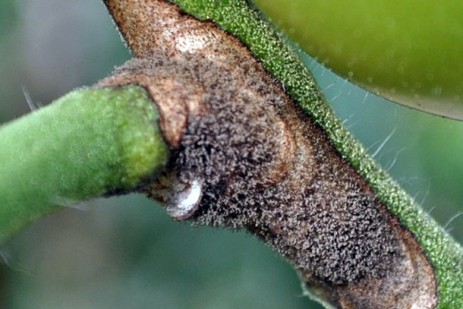Although high tunnels provide direct protection from rain, high relative humidity and dew can still provide the moisture necessary for disease development. Gray mold affects many different types of vegetables and ornamentals, so there are many potential sources of this pathogen. It easily grows on weakened or senescing (dying) plant tissue such as old flower blossoms or leaf litter and can cause lesions on the leaves and stems.
Sometimes the gray mold foliar lesions can be confused with late blight since both are irregular in shape. However, gray mold will develop more of a concentric ring pattern, the fuzzy growth (sporulation) is darker and grayer in color, and can develop on both the upper and lower leaf surface as well as cause lesions on the surface of the plant stem. The stems become girdled, break, and foliar symptoms may become severe enough to cause defoliation. The fruit can become infected from dying flower petals that hang on as the fruit develop. These lesions are whitish, very soft and watery, and typically develop near the stem end. This is in complete contrast to late blight that causes dark-brown, greasy, firm lesions on the fruit.
Gray mold is a very good saprophyte, and general sanitation is important. Growers should also maximize and maintain good air circulation through cultural practices. Disease development is favored by temperatures from 64 to 75°F and typically develops on the mature plants that have dense canopies. Foliar applications of products such as Scala (FRAC code 9, 1-day PHI), Botran (FRAC code 14, 0-day PHI), and Fontelis (FRAC code 7, 0-day PHI) will help manage the disease and are labeled for use in a greenhouse (and high tunnel) tomato production.
Even this late in the season, if you suspect late blight, please contact your local Penn State Extension Office or let Beth Gugino know via email at [email protected] or by phone at 814-865-7328.
It is important that we collect a sample to characterize the genotype. The presence of a new genotype could alter our current and future management recommendations. For the latest reports visit USAblight.org.

Botrytis gray mold (A and B) foliar and stem lesions on tomato. Note the darker gray sporulation on the stem lesions. Compare that to late blight on tomato (C and D). In these pictures note the pale green surrounding the lesion on the upper leaf surface (C) and the whiter sporulation (D) that will only be on the lower leaf surface. Photos: Beth K. Gugino/Penn State

– Beth Gugino, Penn State University
Photo at top: Gray mold sporulation has a dark gray, concentric ring pattern and may develop lesions on the surface of the plant stems. Photo: Beth K. Gugino/Penn State

















